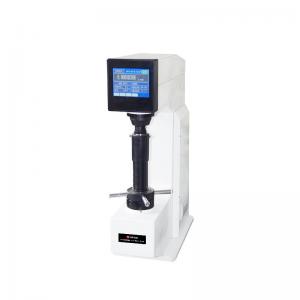
Add to Cart
Lcd Display Digital Hardness Tester , Double Rockwell Hardness Testing Machine
Mitech MHRX-45-150DX Digital Double Rockwell Hardness Tester, based on the mechanical principle of conical diamond or hard alloy indenter pressing into the sample surface to produce indentation, realizing the material hardness measurement by measuring the depth of the indentation. Capable of inspecting the finished or semi-finished parts of the machined sample, it is suitable for high accuracy hardness testing for batches parts with various metal or non-metallic materials. According to statistics, Rockwell hardness testing is the most widely used hardness testing method in metal processing industry, which utilization ratio is more than 70%. With novel appearance, stable performance and integration of electro mechanical integration and touch screen, it can be tested on the hardness of all rockwell and surface rockwell scale. It is widely used in metal processing and manufacturing, various metal material’s failure analysis and other fields like colleges and research institutions, and it is the sophisticated detection equipment to test the Rockwell hardness of metal and other materials.
The Rockwell hardness test is taking the diamond cone with 120°apex angle or the hardened steel ball with specified diameter as the indenter to press into sample surface with specific test force, then get the Rockwell hardness of the measured metallic materials according to the sample surface indentation depth.
The Rockwell hardness measurement principle is shown as below figure. 0-0 is the position that the diamond indenter is not yet in contact with the sample. 1-1 figure is the indenter position under the affect of the preliminary test force, the indentation depth is h1. The preliminary test is to eliminate the influence to the testing result accuracy caused by the roughness of the sample surface. 2-2 in the figure is the indenter position under the influence of the testing force (the preliminary test force and the main test force). The depth is h2. 3-3 in the figure is the indenter position after dismounting the main test force. As the metal elasticity will recovery some degree after deformation, the really indentation depth of the indenter is h3. The plastic deformation caused by the main test force make the indenter pressing into the depth is h=h3-h1. Rockwell hardness value is determined by the size of h, the greater the depth h, the lower the hardness, otherwise, the higher the hardness.
In the traditional concept, usually use a constant C minus h to represent the level of hardness, while the depth of indentation per 0.002mm as a unit of hardness. The hardness value obtained is called the Rockwell hardness value, denoted by the symbol HR.
![]()
In the formula, c is a constant (for HRC, HRA, c is 0.2; for HRB, c is 0.26). The Rockwell hardness value HR obtained is an unknown number which is usually read directly on the test machine indicator when testing.

Rockwell hardness tester working principle Figure
It should be noted that the measured hardness values would be different with different indenter and test force. Therefore, the Rockwell hardness testing specifies 15 different hardness test scales according to the different indenter specification and test force sizes. And the HRB, HRC, HRA are the most widely used.
Features
Applications
Configurations
| NO. | Name | QTY. | Remarks | |
|
Standard Configuration | 1 | Main unit | 1 | |
| 2 | Diamond Rockwell indenter | 1 | ||
| 3 | Φ1.5875mm 1/16in ball indenter | 1 | ||
| 4 | Thermal printing paper | 1 | ||
| 5 | Small Testing Table | 1 | ||
| 6 | Large Testing Table | 1 | ||
| 7 | V-shape Testing Table | 1 | ||
| 8 | Standard Rockwell Hardness Blocks | 3 | ||
| 9 | Standard surface Rockwell hardness block | 2 | ||
| 10 | RS232 communication cable | 1 | ||
| 11 | Fuse | 2 | ||
| 12 | Power cable | 1 | ||
| 13 | Plastic dust cover | 1 | ||
| 14 | Attached files | 1 | ||
| 15 | ABS instrument case | 1 | ||
|
Optional Configuration | 1 | Φ3.175mm 1/8inch ball indenter | 1 | Mainly used for testing hard plastic non-ferrous materials |
| 2 | Φ6.35mm 1/4inch ball indenter | 1 | ||
| 3 | Φ12.7mm 1/2inch ball indenter | 1 |
Maintenance and care